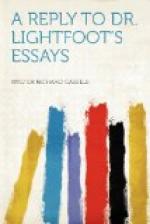On the one hand, therefore, all the historical data which we possess regarding the reign and character of Trajan discredit the story that Ignatius was sent to Rome to be exposed to beasts in the Coliseum; and all the positive evidence which exists, independent of the Epistles themselves, tends to establish the fact that he suffered martyrdom in Antioch. On the other hand, all the evidence which is offered for the statement that Ignatius was sent to Rome is more or less directly based upon the representations of the letters, the authenticity of which is in discussion, and it is surrounded with improbabilities of every kind. And what is the value of any evidence emanating from the Ignatian Epistles and martyrologies? There are three martyrologies which, as Ewald says, are “the one more fabulous than the other.” There are fifteen Epistles all equally purporting to be by Ignatius, and most of them handed down together in MSS., without any distinction. Three of these, in Latin only, are universally rejected, as are also other five Epistles, of which there are Greek, Latin, and other versions. Of the remaining seven there are two forms, one called the Long Recension and another shorter, known as the Vossian Epistles. The former is almost unanimously rejected as shamefully interpolated and falsified; and a majority of critics assert that the text of the Vossian Epistles is likewise very impure. Besides these there is a still shorter version of three Epistles only, the Curetonian, which many able critics declare to be the only genuine letters of Ignatius, whilst a still greater number, both from internal and external reasons, deny the authenticity of the Epistles in any form. The second and third centuries teem with pseudonymic literature, but I venture to say that pious fraud has never been more busy and conspicuous than in dealing with the Martyr of Antioch. The mere statement of the simple and acknowledged facts regarding the Ignatian Epistles is ample justification of the assertion, which so mightily offends Dr. Lightfoot, that “the whole of the Ignatian literature is a mass of falsification and fraud.” Even my indignant critic himself has not ventured to use as genuine more than the three short Syriac letters [114:1] out of this mass of forgery, which he rebukes me for holding so cheap. Documents which lie under such grave and permanent suspicion cannot prove anything. As I have shown, however, the Vossian Epistles, whatever the value of their testimony, so far from supporting the claims advanced in favour of our Gospels, rather discredit them.
I have now minutely followed Dr. Lightfoot and Dr. Westcott in their attacks upon me in connection with Eusebius and the Ignatian Epistles, and I trust that I have shown once for all that the charges of “misrepresentation” and “misstatement,” so lightly and liberally advanced, far from being well-founded, recoil upon themselves. It is impossible in a work like this, dealing with such voluminous materials, to escape errors of detail, as both of these gentlemen bear witness, but I have at least conscientiously endeavoured to be fair, and I venture to think that few writers have ever more fully laid before readers the actual means of judging of the accuracy of every statement which has been made.




